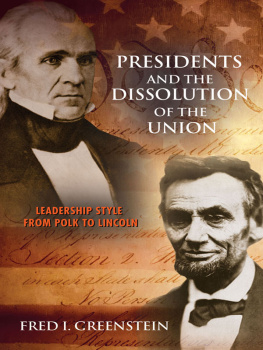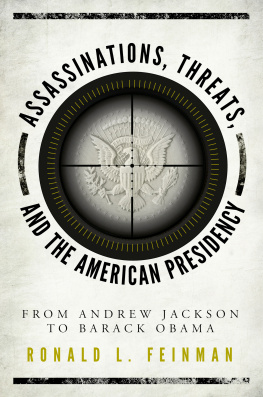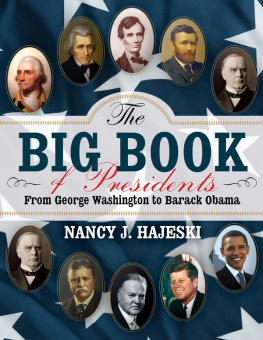Copyright 2013 by Princeton University Press
Published by Princeton University Press, 41 William Street, Princeton, New Jersey 08540
In the United Kingdom: Princeton University Press, 6 Oxford Street, Woodstock, Oxfordshire OX20 1TW
press.princeton.edu
All Rights Reserved
Library of Congress Cataloging-in-Publication Data
Greenstein, Fred I., author.
Presidents and the dissolution of the Union : leadership style from Polk to Lincoln / Fred I. Greenstein with Dale Anderson.
pages cm
Includes bibliographical references and index.
ISBN 978-0-691-15199-1 (hardback)
1. PresidentsUnited StatesHistory19th century. 2. PresidentsUnited StatesBiography. 3. Political leadershipUnited StatesCase studies. 4. United StatesPolitics and government17831865. I. Title.
E176.1.G8294 2013
973.099dc23 2012049032
British Library Cataloging-in-Publication Data is available
This book has been composed in Minion Pro
Printed on acid-free paper.
Printed in the United States of America
1 3 5 7 9 10 8 6 4 2

CHAPTER 1

The Presidential Difference in the Civil War Era
It was not events alone that caused Northerners and Southerners to view each other as enemies. Politicians were largely responsible for the ultimate breakdown of the political process.
Michael F. Holt, The Political Crisis of the 1850s
THE MID-NINETEENTH CENTURY witnessed an unprecedented failure of the American political system. After two decades of increasingly bitter sectional disagreement, a disastrous war erupted between the North and the South that took the lives of roughly 2 percent of the nations population, left much of the South devastated, and radically remade Southern society. So much has been written on this period, it might be assumed that no more remains to be said. Nothing could be further from the truth. The Civil War era is so intellectually fertile that new ways to explore it constantly arise.
PRESIDENTIAL LEADERSHIP
In the pages that follow, I use the period from 1846 to 1865 as a stage on which a group of American presidents exhibit their strengths and weaknesses. The events of the period from the Mexican-American War to the Civil War form the background of that stage. Six chief executivesJames K. Polk, Zachary Taylor, Millard Fillmore, Franklin Pierce, James Buchanan, and Abraham Lincolnoccupy its foreground. These men merit attention because of the demands placed on the chief executive in this momentous era and because they varied so greatly in the caliber of that leadership, ranging from Abraham Lincoln, who ranked first in presidential greatness in a recent poll of historians of the presidency, to James Buchanan, who ranked last.
This is the third in a series of books that ask what enables some American presidents to meet the challenges of their times and causes others to fail. In The In all these works, my approach is straightforward. I proceed chronologically, summarizing the formative years, rise to the presidency, and administrations of the protagonists. I then conclude each chapter by assessing the strengths and weaknesses of the president in question by focusing on six realms: public communication, organizational capacity, political skill, policy vision, cognitive style, and emotional intelligence.
Why these qualities? Public communication, using what Theodore Roosevelt called the bully pulpit, may be thought of as the outer face of the presidency. The ability to articulate goals and rally public support for them is fundamental to presidential leadership. Organization can be viewed as the inner face of the office. The ability to organize and run an administration is vital to a successful presidency. In the smaller administrations of this period, cabinets had much greater significance than they do today. How these presidents filled their cabinets and used those officials and other advisers offers instructive comparisons.
It might be assumed that anyone able to rise to the presidency would be politically skilled, but a surprising number of chief executives has lacked either one or both of two kinds of political skill. Tactical skill is the ability to get results; strategic skill is the ability to get results that stand the test of time. But these skills alone cannot ensure success. Even a consummately skilled president may be an underachiever if he or she lacks a policy vision. At the same time, a president who advances policies that have undesirable consequences is likely to be worse off than one who lacks vision altogether.
A president also needs the appropriate cognitive style to process the torrent of advice and information that comes his or her way. But even the most cerebral of presidents may go astray in the absence of emotional intelligence, the ability to control ones emotions and turn them to advantage rather than succumbing to disabling emotional flaws. That last, as we shall see, is a quality conspicuously lacking in some of the presidents considered in this volume.
THE CONTEXT OF THE TIMES
It remains to fill in the background against which these six presidents performed their duties. In 1845 James K. Polk entered the White House inspired by the example of his mentor Andrew Jackson to be a strong president and with the intention of accomplishing a small number of explicitly defined goals. One of those goalsthe acquisition of the Mexican province of
Some in the North wanted slavery to be barred from these lands.* Early in the war, Pennsylvania congressman David Wilmot sponsored a measure that would forbid slavery in any territory gained from Mexico. This proposal, the Wilmot Proviso, passed the House of Representatives but not the Senate, but its repeated reintroduction and possible passage was a constant worry to the South until the question was settled in 1850.
The Southern position on the Mexican Cession was staked out in 1847 by John C. Calhoun of South Carolina, who argued that any law prohibiting citizens of any state from entering a territory with their slaves would be a violation of the Constitution.promoting the spread of slavery, marked the extreme in the debate that worried many Northerners.
The political importance of whether states carved from the Mexican Cession would be open to slavery cannot be overstated. At the time, the free states enjoyed a majority of seats in the House, but the North and South had equal representation in the Senate. As a result, the South could block any bills threatening slavery in the Senate. The admission of more free states would overthrow that balance, costing the South this crucial veto power.










 CONTENTS
CONTENTS  CHAPTER 1
CHAPTER 1